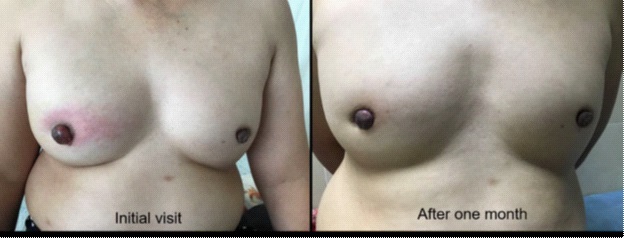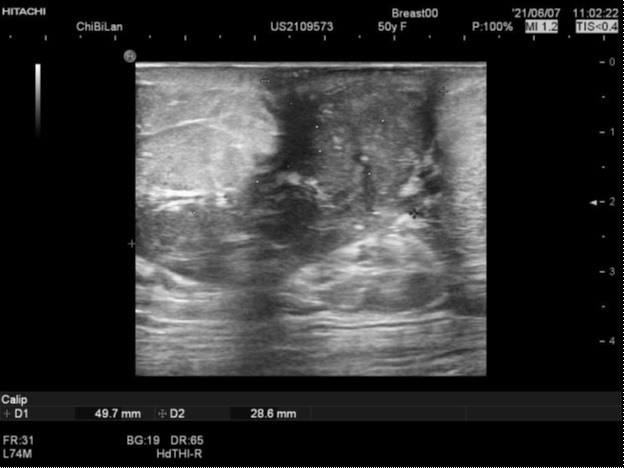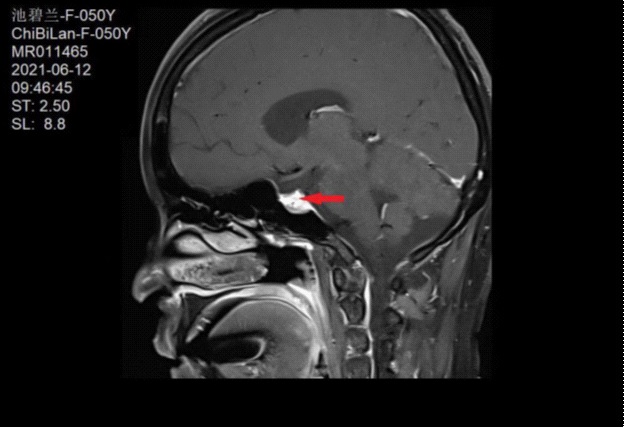
Journal of Clinical Images and Medical Case Reports
ISSN 2766-7820
Research Article - Open Access, Volume 3
HE4 elevated levels correlated with breast cancer progression
Mohamed A Abdelrazek1,2*; Lamiaa A Barakat3; Ahmed Nageb3; Rizk Elbaz4; Amr Abouzid5
1 Biochemistry Labs, Sherbin Central Hospital, Ad Daqahliyah, Ministry of Health, Egypt
2 Research and Development Department, Biotechnology Research Center, New Damietta, Egypt
3 Department of Chemistry, Faculty of Science, Port Said University, Egypt.
4 Genetics Unit, Faculty of Medicine, Mansoura University, Egypt.
5 Department of Surgical Oncology, Oncology Centre, Faculty of Medicine, Mansoura University, Mansoura, Egypt.
*Corresponding Author: Mohamed A Abdelrazek
Biotechnology Research Center, 23 July St., Industrial Zone, New Damietta, 34517, Egypt.
Email: maabdelrazek@yahoo.com
Received : Jan 29, 2022
Accepted : Feb 24, 2022
Published : Mar 03, 2022
Archived : www.jcimcr.org
Copyright : © Abdelrazek MA (2022).
Abstract
Background: Despite several, there were many Breast Cancer (BC)- related deaths around the world. Searching for new analytical tools for BC detection at early stages is widely demanded.
Aim: We aimed to evaluate Human Epididymal Protein 4 (HE4) clinical value in BC development and progression.
Methods: HE4 serum levels were determined by ELISA in females with BC (n=120), benign breast disease (n=40) and healthy women (n=40). Receiver operating characteristic curve was applied for evaluation HE4 diagnostic power.
Results: In BC patients, HE4 [5 (2-11.9) vs. 3.1 (1.8-5.4) and 1 (1- 3.5); P=0.022] was significantly higher than that in benign and healthy females, respectively. Compared to CEA and CA-15.3, it had superior diagnostic ability (AUC=0.783; P<0.0001; 73.3% sensitivity; 63.7% specificity). This ability increase when comparing BC patients to only healthy controls (AUC=0.862; 73.3% sensitivity; 77.5% specificity). Elevated HE4 levels were associated disease progression including multiple lesions, late stages, high grades, large size, lymph node invasion and non-luminal molecular subtypes. Spearman correlation analysis revealed that HE4 high levels significantly (P<0.05) correlated with tumor stage, histological grade and tumor size.
Conclusions: HE4 is inexpensive, rapid, easy to perform and reliably BC biomarker. Moreover, its association with disease severity may support its potential role as prognostic BC marker.
Keywords: breast cancer; detection; HE4; serum; biomarker.
Citation: Abdelrazek MA, Barakat LA, Nageb A, Elbaz R, Abouzid A. HE4 elevated levels correlated with breast cancer progression. J Clin Images Med Case Rep. 2022; 3(3): 1707.
Introduction
Of all new tumor diagnoses in females, only colorectal, lung and breast (BC) cancers account for 51%, with BC alone accounting for almost one/third [1]. Usually, effective treatments are suitable for patients with early stages instead of metastatic patients [2]. Due to limited tools in triple-negative or metastatic BC treatment, overall BC patients morbidity is still increasing [3]. Thus, identifying easy and specific biomarkers associated with BC development and progression is vital for improving BC patients prognosis efficacy [2].
Human Epididymal Protein 4 (HE4) is secretory protein initially identified in human epididymis epithelial cells [4]. Its gene is located on 20q13.12 chromosome long arm [5]. It is one of whey-acidic-proteins that have anti-microbial and anti-inflammatory activity against viruses and gram-negative bacteria [6], as well as a role in regulation of cell angiogenesis [7] and cell growth [8]. At mRNA and protein levels and compared to healthy controls, HE4 was reported to be elevated in ductal BC. Authors also reported that its relative expression may be correlated significantly with tumor progression [9].
As studies evaluating the association between HE4 protein and BC clinicopathological features are very limited, we aimed in this study to further evaluate its clinical value compared to established tumor markers (CEA and CA-15.3). Also, we aimed to evaluate its association with some tumor severity features including, number of lesions, stage, grade, size and lymph node invasion.
Material and methods
Patients
A retrospective study was carried out between Jan and May/2021 including women with BC (n=120), with breast benign diseases (n=40) and 40 age- and gender-matched healthy females. All patients were clinically, radiologically and pathologically screened at the Oncology Center, Mansoura University, Egypt. Patient with inflammatory tumors and metastases, other cancer types or undergone radio-/chemo- therapy were excluded. None of controls (healthy and benign) had any tumor history. BC was pathologically identified according to the tumornodes-metastasis Classification of Malignant Tumours of the Union for International Cancer Control [10]. Study design was approved by Mansoura University Hospitals Ethics and Scientific Committees. Written informed consent was obtained from all participants.
Laboratory assays
After BC diagnosis and according to the manufacturer’s protocol, HE4 was determined by ELISA commercial kit (Sunred Biological Technology, Shanghai, China). Also, all participants were analysed for CEA and CA-15.3 using commercial ELISA kit (My Bio Source, San Diego, USA).
Statistical analysis
Data analyses were performed using Graph Pad Prism and SPSS programs. Based on normality distribution, variables levels were expressed as mean ± SD or median (inter quartile range), appropriately. Qualitative data was expressed as absolute numbers. For differences assessments, ANOVA, Chi-squared (X2) or Kruskal-Wall is tests were appropriately used follwed by LSD as post-hoc test. P value <0.05 is significant. HE4 Diagnostic power for BC was evaluated by Receiver Operating-Characteristic (ROC) curves and cut-off point was determined based on the point closest to the (0, 1) point (the minimal (1-sensitiity)2+(1- specifiity)2) [11]. Correlations were evaluated by Spearman’s rank correlation analysis.
Results
HE4 levels and breast cancer
In comparison between patients and controls, there was no significant (P=0.563) difference in age. Most of participants were postmenopausal. Tumor features including stage, grade, size, lymph node status, hormonal status and HER-2 protein detection were shown in Table 1. Despite CEA and CA-15.3, it was reported that serum HE4 [5 (2-11.9) vs.3.1 (1.8-5.4) and 1 (1- 3.5); P=0.022] in BC patients was more significantly higher than controls (Figure 1).
Table 1: Age, menopause status and tumor characteristics of included females
Parameter |
Healthy |
Benign |
Breast cancer |
P value |
Number |
40 |
40 |
120 |
ـــ |
Age (years) |
48.0 ± 8.9 |
48.5 ± 8.9 |
49.5 ± 11.0 |
0.563a |
Menopause |
18/22 |
16/24 |
43/77 |
0.455b |
CEA (ng/mL) |
2 (1-5) |
3 (2-6) |
4.6 (1-10.8) |
0.101c |
CA-15.3 (ng/mL) |
12.5 (11-15) |
20 (13-22) |
20 (11-27) |
0.181 c |
HE4 (ng/mL) |
1 (1-3.5) |
3.1 (1.8-5.4) |
5 (2-11.9) |
0.022 c |
Lesion |
ـــ |
ـــ |
96/24 |
ـــ |
Tumor size |
ـــ |
ـــ |
56/64 |
ـــ |
Tumor stage |
ـــ |
ـــ |
78/42 |
ـــ |
Tumor grade |
ـــ |
ـــ |
36/84 |
ـــ |
Lymph node (negative/positive) |
ـــ |
ـــ |
60/80 |
ـــ |
Estrogen receptor (negative/positive) |
ـــ |
ـــ |
36/84 |
ـــ |
Progesterone receptor |
ــ |
ــ |
33/87 |
ـــ |
HER-2/neu (negative/positive) |
ــ |
ــ |
42/78 |
ــ |
Abbreviations: CEA: carcinoembryonic antigen; CA-15.3: cancer antigen 15.3 and HE4: human epididymal protein 4. Differences between groups were established by a ANOVA, b Chi-squared (X2) or c Kruskal-Wallis tests, appropriately.
HE4 clinical value in BC detection
According to ROC curve for BC detection, HE4 (AUC=0.783; P<0.0001) had superior diagnostic power compared to CEA and CA-15.3 (Figure 2 and Table 2). At cut-off >2 ng/mL, HE4 sensitivity and specificity were 73.3 and 63.7%, respectively.In early stages detection, this good diagnostic performance did not significantly affect (Table 2). This ability increase when comparing BC patients to only healthy controls (AUC=0.862; sensitivity=73.3%; specificity=77.5%; Table 2).
Table 2: Age, menopause status and tumor characteristics of included females.
Marker |
AUC |
P value |
Cutoff |
Sensitivity |
Specificity |
BC from all non-cancer individuals |
|||||
CEA |
0.570 |
0.229 |
2.6 |
61.7 |
50 |
CA-15.3 |
0.619 |
0.035 |
14.5 |
65 |
56.3 |
HE4 |
0.783 |
<0.0001 |
2.0 |
73.3 |
63.7 |
Patients with early stages (T>2) from all non-cancer individuals |
|||||
CEA |
0.547 |
0.434 |
2.6 |
56.4 |
50 |
CA-15.3 |
0.602 |
0.087 |
14.5 |
61.5 |
56.3 |
HE4 |
0.733 |
<0.0001 |
2.0 |
69.2 |
62.5 |
BC from healthy individuals |
|||||
CEA |
0.621 |
0.111 |
2.6 |
61.7 |
56.3 |
CA-15.3 |
0.690 |
0.011 |
14.5 |
65 |
72.5 |
HE4 |
0.862 |
<0.0001 |
2.0 |
73.3 |
77.5 |
HE4 was correlated with disease progression
Elevated HE4 serum levels were associated disease progression (Figure 3). These increased levels were associated with multiple lesions (Figure 3A), late stages (Figure 3B), high grades (Figure 3C), large size (Figure 3D) and lymph node invasion (Figure E). Moreover, HE4 levels were higher in non-luminal compared to luminal tumor molecular subtypes (Figure 3F). Spearman correlation analysis revealed also that HE4 high levels significantly (P<0.05) correlated with tumor stage (r=0.29), grade (r=0.26) and tumor size (r=0.27) (Table 3).
Table 3: Correlation between HE4 and some tumor features.
Factor |
Spearman correlation |
|
r |
P value |
|
Lesions |
0.17 |
0.128 |
Tumor T stage |
0.19 |
0.116 |
Tumor grade |
0.26 |
0.027 |
Lymph node |
0.15 |
0.123 |
Clinical stage |
0.14 |
0.691 |
Tumor size |
0.27 |
0.016 |
Discussion
In clinical practice, BC is a heterogeneous disorder that is frequently diagnosed [12]. Despite several optional BC the rapeutic strategies, there were many related deaths around the world [12]. Thus, BC analytical tools for its detection at disease early stages, as well as during its follow-up and management, are widely demanded [13].
After its first detection as a transcript expressed in epididymis of respiratory tract [14], HE4 was frequently used as epithelial ovarian tumor serum biomarker [15]. Subsequently, it was demonstrated to be expressed in ductal BC and limited studies reported its clinical value [14,16]. Here, we aimed to evaluate a blood HE4 easy test in BC detection using two controls group (patients with benign breast disorders and healthy females). Our observations indicate that serum HE4 [5 (2-11.9) vs.3.1 (1.8-5.4) and 1 (1-3.5); P=0.022] in malignant BC patients was more significantly higher than benign and healthy controls, respectively. Also, it (AUC=0.783) had superior diagnostic ability for BC compared to CEA and CA-15.3. HE4 sensitivity (73.3%) and specificity (63.7%) were reasonable in distinguishing BC from benign and healthy females. This ability increase when comparing BC patients to only healthy controls (AUC=0.862; sensitivity=73.3%; specificity=77.5%).
These results demonstrate that HE4 may be used as a predictive BC marker. Galgano et al., reported HE4 mRNA and protein level of in normal and malignant BC tissues [14]. In addition using clear immunohistochemical staining, Kamei et al., found increased HE4 expression in BC cells and they reported its association with lymph node invasion [17]. Sai Baba et al. and Gündüz et al. also evaluated serum HE4 diagnostic potential of in BC detection and their results are consistent with our results [16,18]. In cancer cell migration, adhesion, growth and metastasis, it was demonstrated that HE4 can act as positive regulator through activating EGFR-MAPK and PI3K/AKT signalling pathways [19,20].
Elevated HE4 serum levels were associated disease progression including multiple lesions, late stages, high grades, large size and lymph node invasion. Also, HE4 levels were higher in non-luminal compared to luminal tumor molecular subtypes. Similar to these findings, Mirmohseni Namini et al. observed in BC patients that relative HE4 mRNA expression was significantly correlated with cancer cells differentiation grade, tumorstage, and tumor size. Also, they found that patients with lymph node involvement had significantly higher HE4 plasma levels than patients without involvement [9]. Moreover, Akoz et al. reported that HE4 expression rises in patients with BC subtypes that associated with poor prognosis [21].
Conclusion
In conclusion in this report, expression levels of HE4 were increased in BC patients compared to benign and healthy controls. It had superior diagnostic ability compared to other established biomarkers (CEA and CA-15.3) BC screening. This study may include some limitations like retrospective nature and single-center patient’s cohort. Thus, future more multicentric comprehensive studies are required to examine HE4 prospective analysis.
References
- Siegel RL, Miller KD, Fuchs HE, Jemal A. Cancer statistics, 2022. CA Cancer J Clin. 2022; 72: 7-33.
- Sun C, Lu B, Liu Y, et al. Corrigendum: Reduced Effectiveness and Comparable Safety in Biweekly vs. Weekly PEGylated Recombinant Human Growth Hormone for Children With Growth Hormone Deficiency: A Phase IV Non-Inferiority Threshold Targeted Trial. Front Endocrinol (Lausanne) 2021; 12: 830469.
- Caldana M, Pellini F, Lombardi D, Mirandola S, Invento A, Pollini GP, et al. Breast cancer and neoadjuvant chemotherapy: Indications for and limits of breast-conserving surgery. Ann Ital Chir. 2018; 89: 392-397.
- Kirchhoff C, Habben I, Ivell R, Krull N. A major human epididymis-specific cDNA encodes a protein with sequence homology to extracellular proteinase inhibitors. Biol Reprod. 1991; 45: 350-357.
- Bingle L, Singleton V, Bingle CD. The putative ovarian tumour marker gene HE4 (WFDC2), is expressed in normal tissues and undergoes complex alternative splicing to yield multiple protein isoforms. Oncogene. 2002; 21: 2768-2773.
- Drannik AG, Henrick BM, Rosenthal KL. War and peace between WAP and HIV: Role of SLPI, trappin-2, elafin and ps20 in susceptibility to HIV infection. Biochem Soc Trans. 2011; 39: 1427-1432.
- Devoogdt N, Hassanzadeh Ghassabeh G, Zhang J, Brys L, De Baetselier P, Revets H, et al. Secretory leukocyte protease inhibitor promotes the tumorigenic and metastatic potential of cancer cells. Proc Natl Acad Sci U S A. 2003; 100: 5778-5782.
- Simpkins FA, Devoogdt NM, Rasool N, et al. The alarm antiprotease, secretory leukocyte protease inhibitor, is a proliferation and survival factor for ovarian cancer cells. Carcinogenesis. 2008; 29: 466-472.
- Mirmohseni Namini N, Abdollahi A, Movahedi M, Emami Razavi A, Saghiri R, et al. HE4, A New Potential Tumor Marker for Early Diagnosis and Predicting of Breast Cancer Progression. Iranian journal of pathology. 2021; 16: 284-296.
- O’Sullivan B, Brierley J, Byrd D, et al. The TNM classification of malignant tumours-towards common understanding and reasonable expectations. The Lancet. Oncology. 2017; 18: 849-851.
- Perkins NJ, Schisterman EF. The inconsistency of “optimal” cutpoints obtained using two criteria based on the receiver operating characteristic curve. Am J Epidemiol. 2006; 163: 670-675.
- Zou J, Gu Y, Zhu Q, Li X, Qin L, et al. Identifying Glycolysis-related Lnc RNAs for predicting prognosis in breast cancer patients. Cancer Biomark. 2022.
- Freitas M, Neves M, Nouws HPA, Delerue-Matos C, et al. Quantum dots as nanolabels for breast cancer biomarker HER2-ECD analysis in human serum. Talanta. 2020; 208: 120430.
- Galgano MT, Hampton GM, Frierson HF, Jr. Comprehensive analysis of HE4 expression in normal and malignant human tissues. Mod Pathol. 2006; 19: 847-853.
- James NE, Emerson JB, Borgstadt AD, et al. The biomarker HE4 (WFDC2) promotes a pro-angiogenic and immunosuppressive tumor microenvironment via regulation of STAT3 target genes. Sci Rep. 2020; 10: 8558.
- Gündüz UR, Gunaldi M, Isiksacan N, Gündüz S, Okuturlar Y, Kocoglu H, et al. A new marker for breast cancer diagnosis, human epididymis protein 4: A preliminary study. Molecular and clinical oncology. 2016; 5: 355-360.
- Kamei M, Yamashita S, Tokuishi K, et al. HE4 expression can be associated with lymph node metastases and disease-free survival in breast cancer. Anticancer Res. 2010; 30: 4779-4783.
- Sai Baba KSS, Rehman MA, Pradeep Kumar J, et al. Serum Human Epididymis Protein-4 (HE4) - A novel Approach to Differentiate Malignant Frombenign Breast Tumors. Asian Pac J Cancer Prev. 2021; 22: 2509-2507.
- Chen Y, Huang L, Wang S, et al. WFDC2 contributes to Epithelial-Mesenchymal Transition (EMT) by activating AKT signaling pathway and regulating MMP-2 expression. Cancer Manag Res. 2019; 11: 2415-2424.
- Lu R, Sun X, Xiao R, Zhou L, Gao X, Guo L, et al. Human epididymis protein 4 (HE4) plays a key role in ovarian cancer cell adhesion and motility. Biochem Biophys Res Commun 2012; 419: 274-280.
- Akoz G, Diniz G, Ekmekci S, Ekin ZY, Uncel M, et al. Evaluation of human epididymal secretory protein 4 expression according to the molecular subtypes (luminal A, luminal B, human epidermal growth factor receptor 2-positive, triple-negative) of breast cancer. Indian J Pathol Microbiol. 2018; 61: 323-329.



